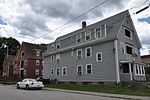House at 34 Benefit Street
1870 establishments in MassachusettsHouses completed in 1870Houses in Southbridge, MassachusettsHouses on the National Register of Historic Places in Worcester County, MassachusettsNational Register of Historic Places in Southbridge, Massachusetts ... and 1 more
Worcester County, Massachusetts Registered Historic Place stubs

The House at 34 Benefit Street in Southbridge, Massachusetts is a modest factory worker's cottage built by the American Optical Company during a period of its expansion in the 1870s. After opening its new Main Plant in The Flats section of Southbridge, workers began to migrate there from the Globe Village neighborhood, increasing demand for housing in that area. It is a narrow 1+1⁄2-story wood-frame structure, which has some architectural style despite its simplicity. The styling is basically Italianate in influence, with wide eaves, and a porch with decorative posts, balustrade, and brackets.The house was listed on the National Register of Historic Places in 1989.
Excerpt from the Wikipedia article House at 34 Benefit Street (License: CC BY-SA 3.0, Authors, Images).House at 34 Benefit Street
Lens Street,
Geographical coordinates (GPS) Address Nearby Places Show on map
Geographical coordinates (GPS)
| Latitude | Longitude |
|---|---|
| N 42.075277777778 ° | E -72.029444444444 ° |
Address
Lens Street 66
01550
Massachusetts, United States
Open on Google Maps











